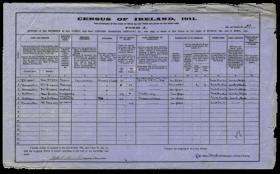Release the 1926 Census!
Published in 20th Century Social Perspectives, 20th-century / Contemporary History, General, Issue 5 (Sep/Oct 2008), News, Volume 16
The 1911 census return (in Irish) for the household of Patrick Pearse. The census returns for 1911 and 1926 stand like two enormous book-ends, between which lie the monumentally important political, social and cultural events that have shaped our subsequent history. (National Archives of Ireland)
As Catríona Crowe of the National Archives explained in the May/June 2008 issue of History Ireland, the 1901 and 1911 census returns for the entire island of Ireland have been available for public research for over 40 years. In outlining the National Archives programme for the digitisation of the 1911 census, Catríona detailed the type of information available in the census returns—including her finding of no fewer than 453 John Murphys in Dublin city and county! Whether you’re a Murphy or not, public interest in this research facility has been nothing short of phenomenal. After completing the digitisation of the 1911 census, the National Archives plan to commence work on the 1901 census and eventually this too will be freely available via the internet, possibly as early as late next year.
But 1911—that’s all of 97 years ago; what about later census returns? The current restriction on public access to the census returns taken since independence in 1922 stems from section 35 of the Statistics Act (1993), which provides for a closure period of 100 years. This 100-year rule is in stark contrast to other western democracies (with the exception of the UK). In the United States, for example, the census returns for 1930 are available online, along with those for each of the preceding decades for which census returns exist, back to 1790.
In 1993, during the debate on the Statistics Bill in Seanad Éireann and on behalf of the then Dún Laoghaire Genealogical Society (now the Genealogical Society of Ireland), I urged senators to reduce the closure period to between 50 and 70 years to allow for the opening of the 1926 census for genealogical research. Indeed, the importance of census returns to genealogy was recognised by Minister of State Noel Dempsey TD when he introduced the bill’s second stage on 17 June 1993.

The burnt out shell of the GPO after the 1916 Rising. The period between 1911 and 1926 was arguably the most turbulent in modern Irish history, both politically and socially. The release of the 1926 census is essential to complete our understanding of this period. (National Museum of Ireland)
Opposition Senator Maurice Manning put down an amendment at committee stage reducing the period of closure to 50 years. This amendment was withdrawn, however, at the request of the minister, who would only consider a 70-year closure period. In the event, even that amendment was not pressed and the bill finally passed all stages in Dáil Éireann on 7 July 1993. The Genealogical Society of Ireland has campaigned ever since for a reversal of this rather bureaucratically fixated 100-year rule.
Many of the people recorded in the 1926 census were born before the civil registration of births, marriages and deaths began in Ireland in 1864. Indeed, it is entirely likely that every adult recorded in that census is now dead. The issue of a breach of confidentiality doesn’t arise because the data recorded in the 1926 census, just as explained by Catríona Crowe in her fine article on the 1911 census, comprise simply forename, surname, age, marital status, relationship to head of household, religion, occupation and where born, etc.—vitally important information for genealogists.
The census returns for 1821, 1831, 1841 and 1851 were all destroyed in the fire at the Public Records Office in the Four Courts in June 1922 at the outbreak of the Civil War. The returns for 1861 and 1871 were officially destroyed after the extraction of the statistical data, and those for 1881 and 1891 were pulped by the UK authorities during the First World War. The census that was due to be taken in 1921 was abandoned during the War of Independence.
The period between 1911 and 1926 was arguably the most turbulent in modern Irish history, both politically and socially. It saw the outbreak of the First World War in 1914 (in which c. 50,000 Irishmen lost their lives before it ended in 1918), the 1916 Easter Rising, the general election of 1918 and the establishment of the first Dáil in 1919. The Declaration of Independence by the first Dáil on 21 January 1919 (a date peculiarly not officially marked in Ireland) was immediately followed by the War of Independence until a truce was declared in 1921. After very difficult negotiations, the treaty with Britain was signed in 1921, establishing the Irish Free State in 1922. The birth of the Free State was greeted by division and a bitter civil war, which finally ended in 1923. This traumatic period in Irish history was also marked by severe economic depression, high emigration and some population shift on the island.
It is as if the census returns for 1911 and 1926 stand like two enormous book-ends, between which lie the monumentally important political, social and cultural events that have shaped our subsequent history. The release of the 1926 census is essential to complete our understanding of this period. Therefore, on behalf of the Genealogical Society of Ireland, I drafted the Statistics (Heritage Amendment) Bill (2008), which Senator Labhrás Ó Murchú has enthusiastically agreed to sponsor. It is hoped to publish the ‘Ó Murchú Bill’ during the coming session of Seanad Éireann.
Though the ideal solution would be to scrap the 100-year rule altogether for all census returns and replace it with, say, a more liberal and enlightened 50-year closure period, we must appreciate the sensibilities that may surround such a proposition. Therefore the creation of a ‘special heritage status’ for the 1926 census, the first taken since independence, should allay any fears about the confidentiality of later census returns. The ‘Ó Murchú Bill’ providing for the release of the 1926 census returns would be an enormously significant contribution to our understanding, knowledge and appreciation of the early years of the independence of our state and its people.
Michael Merrigan is general secretary of the Genealogical Society of Ireland.
















